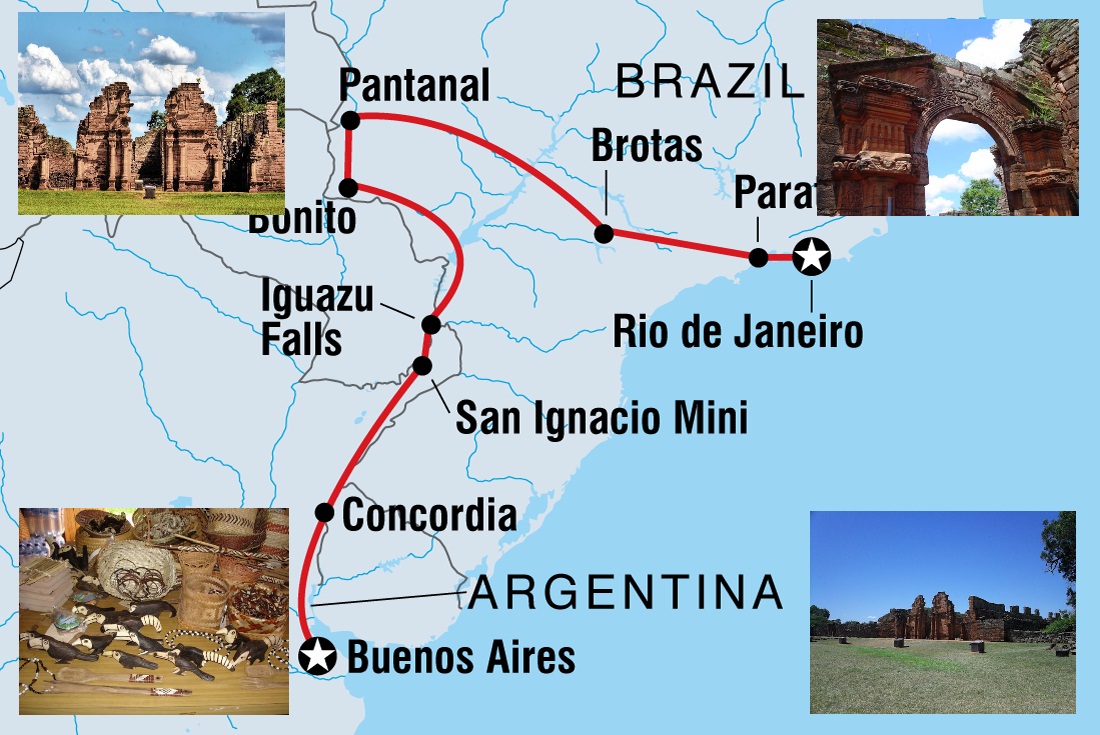
The best-known ruins of the reduction of San Ignacio Miní, a Jesuit mission founded by the Jesuit father, today San Roque González de Santa Cruz at the beginning of the 17th century to evangelize the native Guaraní, are located in the current town of San Ignacio, in the Argentine province of Misiones, about 60 km from the provincial capital, Posadas.
Although the initial seat of San Ignacio Miní (San Ignacio Miní I) is located in the extreme north of the current Brazilian state of Paraná when between the 16th and 18th centuries the territory of that state formed the Spanish-Jesuit region of La Guayrá.
Today San Ignacio Miní is the best preserved of the missions in Argentine territory.
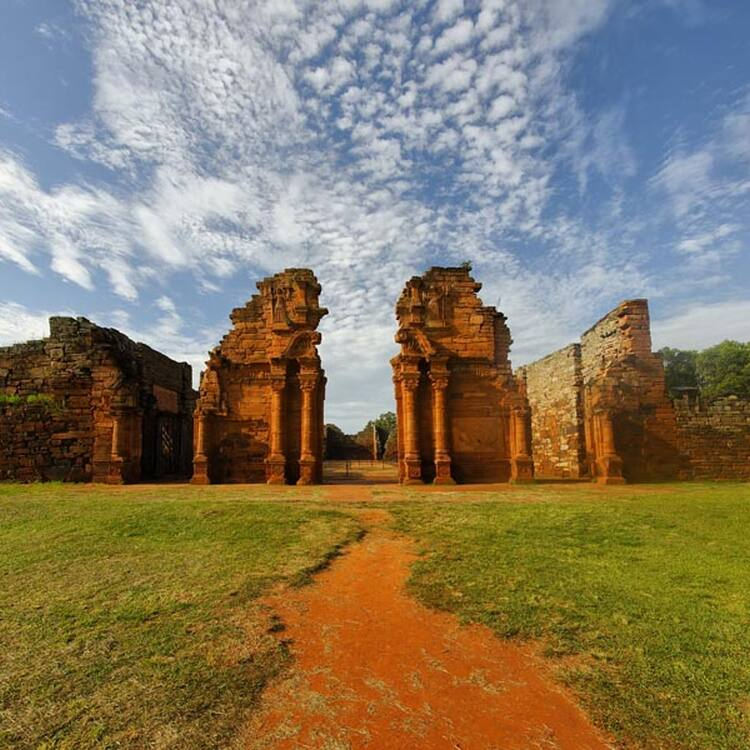
The mission's layout is common to most of those built by the Jesuits at the time: the church, the Fathers' House, the cemetery, the houses and the town hall are distributed around a central plaza.
In the construction of San Ignacio, local stone, red asperón, was used in large pieces. The scale of the work has allowed that, despite years of deterioration, most of the walls remain standing.
The Jesuit Ruins of the Mission of San Ignacio Miní, together with those of Nuestra Señora de Loreto, Santa Ana and Santa María la Mayor (currently in Argentina) and São Miguel (Brazil) were declared World Heritage Sites by UNESCO in 1984.
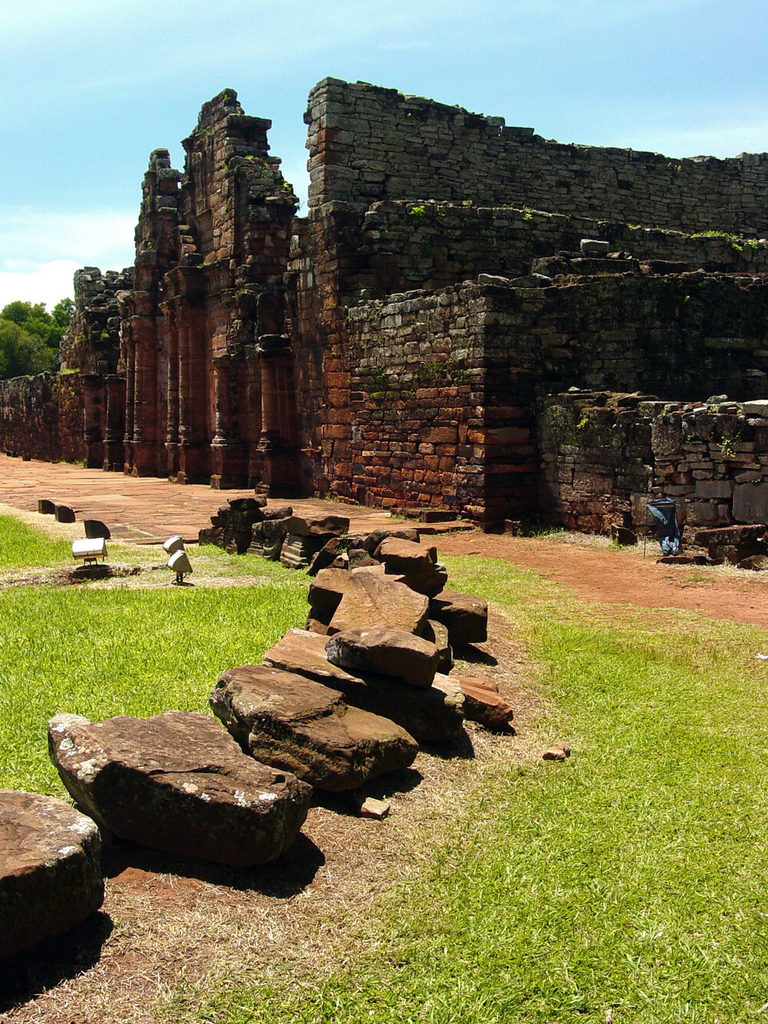
Those of Santísima Trinidad and Jesús, in Paraguay, were declared World Heritage Sites in 1993.
There is also an interpretation centre in the town, which provides information on the history and culture of the missions, as well as organising educational shows.
The ruins of the complex have been inserted into the layout of the current town of San Ignacio. Outside the fenced perimeter there are parts of the urban centre and, beyond, vestiges of various complementary works, such as canals and breakwaters.

The urban layout of the mission (a typology that was repeated in all the others) was organized around the plaza and was presided over by the group that included the town hall and the main temple, with baptistery and vestry, on one side of which were located the house of the fathers, the school, the refectory, the courtyard of the workshops and warehouses; and on the other, the cemetery, the orchard and the coty-guazu.
The strips of housing for the Indians, with their double galleries, completed the limits of the plaza. The main entrance, from the north, was a central street whose perspective, focused on the doorway of the temple, manifests the baroque conception with which the urban space was structured in the missions.
The main temple, with three naves, was built with red ashlar stones from the area, which were originally laid with a perfect fit, without mortar; the roof was of tiles, with two slopes, supported by a wooden structure.
Elaborate designs in carved stone highlighted the main sections of the temple, such as the entrance portal, the vestry, and the one that connected the temple to the school. The Guaraní imprint can be seen in the figures of angels, doves, and motifs of the local flora. The design of other architectural elements, such as the floors and balusters, is very interesting.

Restored between 1940 and 1950, San Ignacio is the best-preserved complex in Argentine territory. Since 1984, it has been included in the UNESCO World Heritage List. It is home to the Jesuit Museum of San Ignacio Miní.
In the Argentine Republic, all the mission complexes found within the site are legally protected at the national level: Santa Ana and Loreto were declared National Historic Monuments in 1983 by National Decree 2217.
San Ignacio was also declared in 1943 by National Decree 16482; and Santa María was declared in 1945 by National Decree 31453.
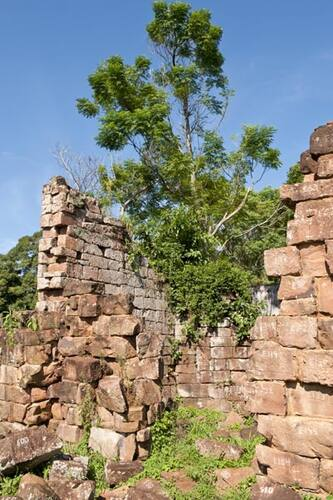
The four sites were also declared Historical Cultural Heritage through the sanction of Provincial Law 1280 of 1983. They are protected and preserved by the National Commission of Museums, Monuments and Historic Places, in accordance with Law 12665.
The National Architecture Service, a component of the Ministry of Public Works and Services, has the primary responsibility for all restoration and maintenance services. The respective agencies shall develop action plans to ensure proper management of the site.
The Technical Planning Department of the Undersecretariat of Strategic Management of the Province of Misiones is in charge of periodic reporting and planning for the conservation of the Argentine Missions, in accordance with national authorities.
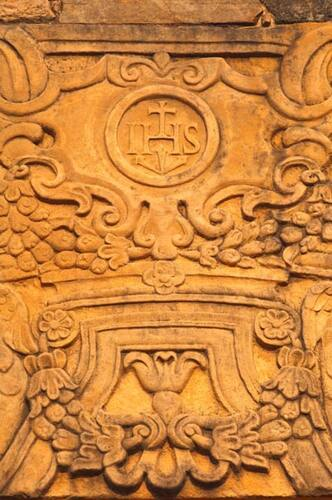
The management plan for the Missions must comply with and be consistent with national legislation regarding historical monuments. It must also consider tourism as part of an effort to provide a broader interpretation of the reduction system and promote cultural activities within the community.
Between 2005 and 2007, workshops were held between the administrators responsible for the historic sites of the Jesuit-Guaraní Mission with the support and cooperation of the World Monuments Fund, the respective national governments and the provincial government of Misiones.
On this UNESCO page we can find all the reasons why they have been declared World Heritage of Humanity: https://whc.unesco.org/en/list/275

Las ruinas más conocidas de la reducción de San Ignacio Miní, una misión jesuítica fundada por el padre jesuita, hoy san Roque González de Santa Cruz a comienzos del siglo XVII para evangelizar a los nativos guaraníes, se encuentran en la actual localidad de San Ignacio, en la provincia argentina de Misiones, distantes unos 60 km de la capital provincial, Posadas.
Aunque el asiento inicial de San Ignacio Miní (San Ignacio Miní I) se ubica en el extremo norte del actual estado brasileño de Paraná cuando entre los siglos XVI y XVIII el territorio de tal estado formaba la región hispanojesuítica de La Guayrá.
En la actualidad San Ignacio Miní es la mejor conservada de las misiones en territorio argentino.
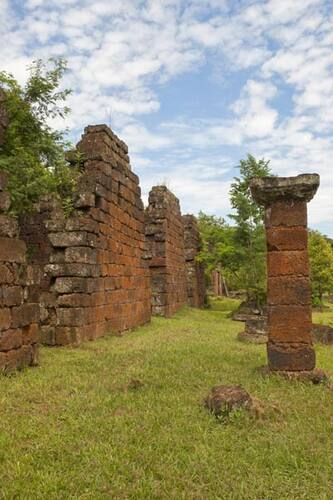
La planta de la misión es la común a la mayoría de las construidas por los jesuitas en la época: alrededor de una plaza central se distribuyen la iglesia, la Casa de los Padres, el cementerio, las viviendas y el cabildo.
En la construcción de San Ignacio se empleó la piedra local, el asperón rojo, en grandes piezas. La dimensión de los trabajos ha permitido que, pese a años de deterioro, la mayor parte de los muros siga en pie.
Las Ruinas Jesuíticas de la Misión de San Ignacio Miní, junto con las de Nuestra Señora de Loreto, Santa Ana y Santa María la Mayor (actualmente en Argentina) y São Miguel (Brasil) fueron declaradas Patrimonio Mundial de la Humanidad por la Unesco en 1984.
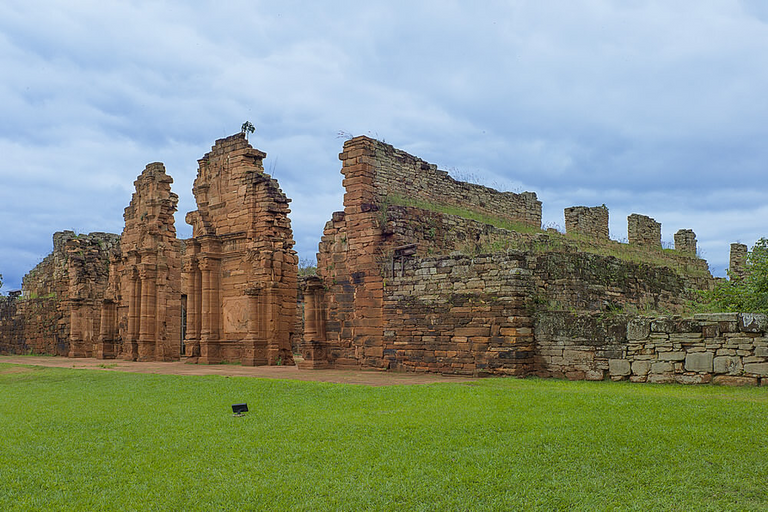
Las de Santísima Trinidad y Jesús, en Paraguay, fueron declaradas Patrimonio de la Humanidad en 1993
En la localidad se encuentra también un centro de interpretación, que provee información de la historia y la cultura de las misiones, además de organizar espectáculos didácticos.
Las ruínas del conjunto han quedado insertas en el trazado del actual pueblo de San Ignacio. Fuera del perímetro cercado se encuentran partes del núcleo urbano y, más allá, vestigios de distintas obras complementarias, como canalizaciones y tajamares.
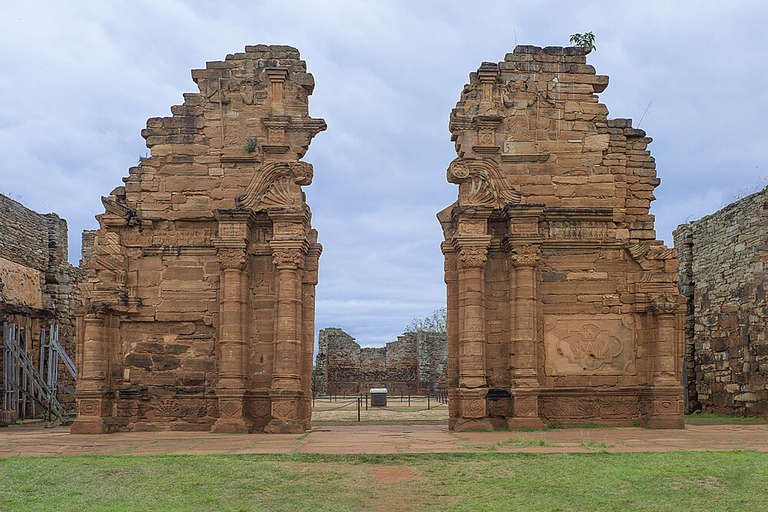
La planta urbana de la misión (tipología que se repetía en todas las demas), se organizaba alrededor de la plaza y estaba presidida por el conjunto que integraban el cabildo y el templo mayor, con baptisterio y sacristía, a uno de cuyos costados se ubicaban la casa de los padres, la escuela, el refectorio, el patio de los talleres y depósitos; y al otro, el cementerio, la huerta y el coty-guazu.
Las tiras de vivienda de los indios, con sus dobles galerías, completaban los límites de la plaza. La entrada principal, desde el norte, era una calle central cuya perspectiva, focalizada en la portada del templo, manifiesta la concepción barroca con que se estructuraba el espacio urbano en las misiones.
El templo mayor, de tres naves, fue construído con piedras de asperón rojo de la zona, que originalmente estaban asentadas con perfecto ajuste, sin argamasa; la cubierta era de tejas, a dos aguas, sostenida por estructura de madera.
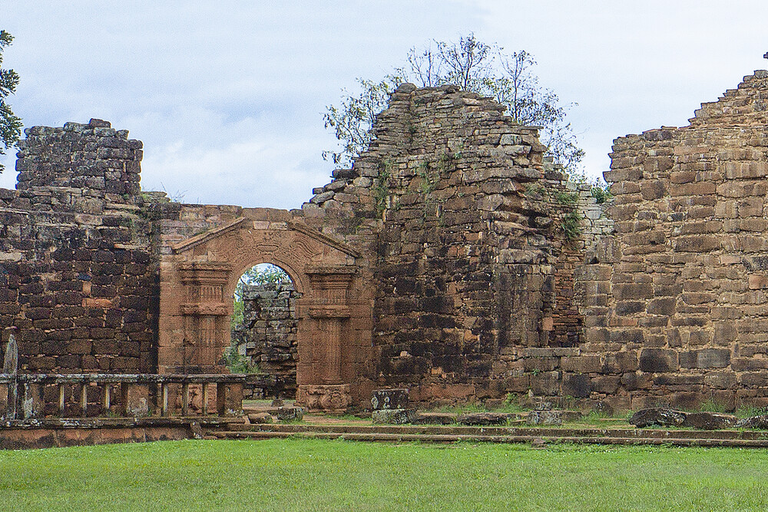
Elaborados diseños en piedra labrada destacaban los sectores principales del templo, como el portal de entrada, el de la sacristía, y el que conectaba el templo con la escuela. En las figuras de ángeles, palomas y motivos de la flora local se aprecia la impronta guaraní. Muy interesante es el diseño de otros elementos arquitectónicos, como los pisos y balaustres.
Restaurado entre 1940/50, San Ignacio es el conjunto mejor conservado en territorio argentino. Desde 1984, integra la lista del Patrimonio Mundial de la UNESCO. Es sede del Museo Jesuítico de San Ignacio Miní.
En la República Argentina, todos los complejos misionales que se encuentran dentro del sitio están protegidos legalmente a nivel nacional: Santa Ana y Loreto fueron declarados Monumentos Históricos Nacionales en 1983 mediante el Decreto Nacional 2217.

A su vez San Ignacio fue declarado en 1943 mediante el Decreto Nacional 16482; y Santa María fue declarada en 1945 mediante el Decreto Nacional 31453.
Los cuatro sitios también fueron declarados Patrimonio Histórico Cultural mediante la sanción de la Ley Provincial 1280 de 1983. Están protegidos y preservados por la Comisión Nacional de Museos, Monumentos y Lugares Históricos, de conformidad con la Ley 12665.
El Servicio Nacional de Arquitectura, un componente del Ministerio de Obras y Servicios Públicos, tiene la responsabilidad principal de todos los servicios de restauración y mantenimiento. Los respectivos organismos deberán desarrollar planes de acción para asegurar la gestión adecuada del sitio.
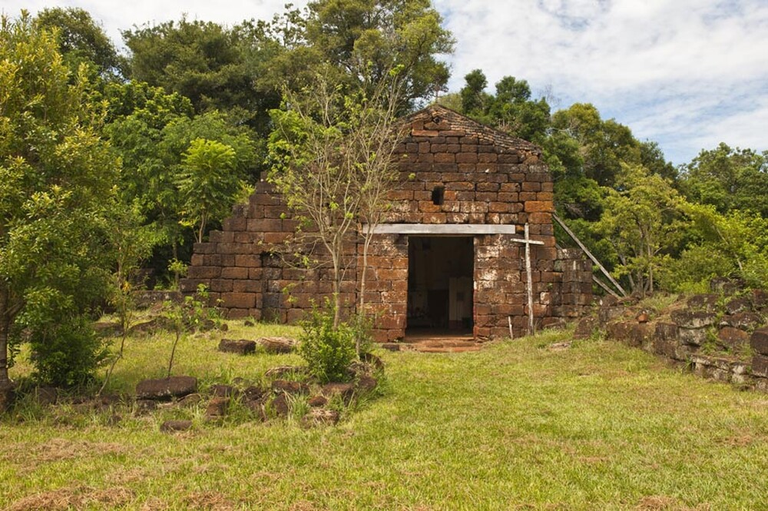
El Departamento de Planificación Técnica de la Subsecretaría de Gestión Estratégica de la Provincia de Misiones está a cargo de la presentación periódica de informes y la planificación para la conservación de las Misiones Argentinas, de acuerdo con las autoridades nacionales.
El plan de gestión de las Misiones debe cumplir y ser coherente con la legislación nacional en materia de monumentos históricos. También debe considerar el turismo como parte de un esfuerzo mayor para brindar una interpretación más amplia del sistema de reducciones y promover las actividades culturales dentro de la comunidad.
Entre 2005 y 2007 se realizaron talleres entre los administradores responsables de los sitios históricos de la Misión Jesuita-Guaraní con el apoyo y la cooperación del Fondo Mundial de Monumentos, los respectivos gobiernos nacionales y el gobierno provincial de Misiones.
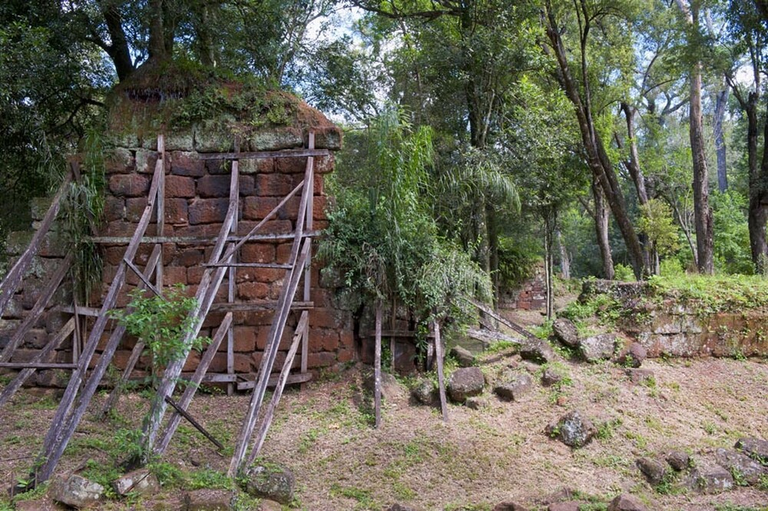
En esta página de la UNESCO podemos encontrar todas las razones por las cuáles han sido declaradas Patrimonio Mundial de la Humanidad: https://whc.unesco.org/en/list/275
Source images / Fuente de las imágenes: UNESCO.

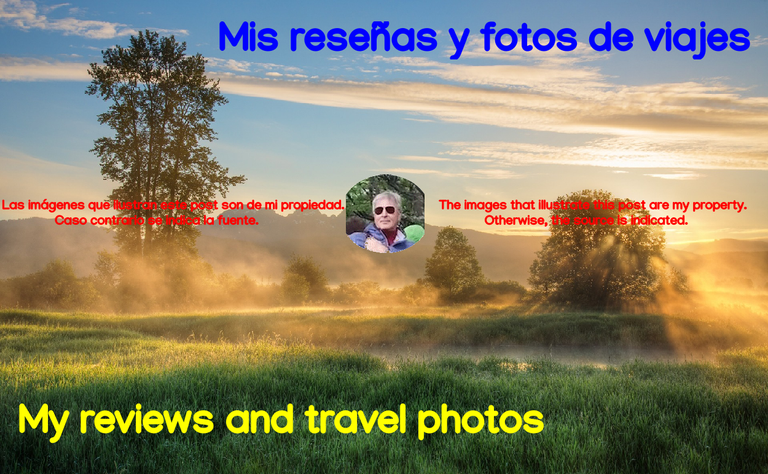
Sources consulted (my property) for the preparation of this article. Some paragraphs may be reproduced textually.
Fuentes consultadas (de mi propiedad) para la elaboración del presente artículo. Algunos párrafos pueden estar reproducidos textualmente.
| Argentina Discovery. |  |
|---|---|
| Galería Fotográfica de Argentina. |  |
| Viaggio in Argentina. |  |
| Patagonia Express. |  |

Upvoted. Thank You for sending some of your rewards to @null. Get more BLURT:
@ mariuszkarowski/how-to-get-automatic-upvote-from-my-accounts@ blurtbooster/blurt-booster-introduction-rules-and-guidelines-1699999662965@ nalexadre/blurt-nexus-creating-an-affiliate-account-1700008765859@ kryptodenno - win BLURT POWER delegationNote: This bot will not vote on AI-generated content
Thanks!